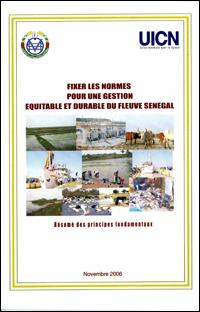

Related content
Lignes directrices sur l’exploitation des espèces menacées
Les sociétés du monde entier exploitent les espèces sauvages, dans une mesure plus ou moins grande, pour l’alimentation, les matériaux de construction, les soins de santé, les médicaments, la lutte contre les parasites, l’ornementation, générer des revenus, les loisirs, ainsi qu’à des fins culturelles et spirituelles. Si cette utilisation des espèces sauvages contribue directement au bien-être de milliards de personnes dans le monde, la surexploitation des espèces sauvages est l’un des principaux facteurs de perte de biodiversité.
Guide sur l’évaluation des impacts cumulatifs sur la biodiversité des projets éoliens et solaires et des infrastructures associées
Un objectif clé de ce guide est de recadrer l’EIC pour aider à soutenir la conservation de la nature et la réalisation des objectifs mondiaux en matière de biodiversité (aux côtés des objectifs climatiques et autres objectifs de développement sociétaux). Ce guide est centré sur la biodiversité et le développement éolien et solaire, et s’adresse principalement aux planificateurs gouvernementaux et aux promoteurs de projets. Cependant, étant donné qu’il est conçu pour aider à relever certains des défis existants de l’EIC, sa portée est potentiellement plus vaste.
Mainstreaming behaviour change in biodiversity conservation
This document presents the findings of a comprehensive needs assessment conducted by the IUCN SSC CEC Behaviour Change Task Force. It is designed to provide a structured understanding of the challenges, opportunities, and actionable recommendations for integrating behavioural sciences into conservation strategies. The report aims to serve as both a diagnostic tool and a roadmap for advancing the application of behavioural sciences in conservation efforts.
Réduction des menaces pesant sur les espèces et restauration en République centrafricaine
This report presents findings from an assessment of the biodiversity conservation potential of four project sites: Lobaye, Mambéré-Kadéï, Ombella-Mpoko, and Sangha-Mbaéré located in the Bangui region of the Central African Republic (CAR). This assessment was done using the Species Threat Abatement and Recovery (STAR) metric, which employs high-resolution imagery and an approach to modelling species’ Area of Habitat (AOH) that was revised after June 2020 among other enhancements. This work was undertaken to better inform threat abatement and restoration planning and implementation at the partner project sites, and as part of a wider effort to pilot and strengthen the use of STAR as a tool for restoration and conservation practitioners, communities, investors, and policymakers.
Global Species Action Plan (Arabic version)
The Global Species Action Plan (GSAP) is a critical initiative developed to support the implementation of the Kunming-Montreal Global Biodiversity Framework (GBF), to address the increasing biodiversity loss worldwide. The GSAP outlines strategic interventions and actions to conserve and sustainably manage species while ensuring equitable benefits. Emphasizing the critical role of species in ecosystem stability, human livelihoods, and cultural heritage, the GSAP seeks to prevent extinctions, reduce threats, and ensure equitable benefits from species use. Implementation involves diverse stakeholders, including governments, Indigenous peoples and Local communities, NGOs, academia, and businesses, fostering cooperation at global, regional, and local levels. The GSAP underscores the collective responsibility to safeguard Earth’s rich biological heritage for future generations.
Unselective, unsustainable, and unmonitored trawl fisheries?
In 2016, the term UUU (unselective, unsustainable and unmonitored) fishing was developed and a Resolution of the World Conservation Congress, adopted by Members, tasked IUCN’s Species Survival Commission with reporting on the concept. The resulting situation analysis utilises the trawl fisheries of China, Thailand and Vietnam to explore how some of the issues associated with UUU fishing can be linked back to these three elements. The report found considerable variation in each component of UUU across the case study countries but that uncontrolled fishery development resulting in excess fishing capacity is commonly a root cause, leaving long standing impacts which have proven very challenging to solve. Whilst the report does not provide recommendations for action, it does identify 14 areas where further work would help accelerate progress on sustainable use, the protection of species of conservation concern and help safeguard the marine ecosystem.
Designing and managing protected and conserved areas to support inland water ecosystems and biodiversity
Inland waters – such as rivers, lakes and other wetlands – are among the most biodiverse ecosystems on the planet. They are also the most threatened; almost one in three species is at risk of extinction and monitored populations of freshwater species have declined by 85% since 1970. The loss of these ecosystems has cascading effects on human livelihoods, cultures and our overall well-being. While protected and conserved areas can play an important role in bending the curve of inland water biodiversity and ecosystem loss, they have rarely been designed, designated, and managed for that purpose. Motivated by the Kunming-Montreal Global Biodiversity Framework’s inclusion of inland waters in the target to conserve 30% of the planet by 2030, this report provides guidance in employing protected areas and other effective area-based conservation measures to benefit these ecosystems and the biodiversity they support. Through a series of case studies and synthesized research, it highlights how integrating the unique needs of inland waters into area-based strategies can improve conservation effectiveness across all realms, build climate resilience and sustain critical ecosystem services.

